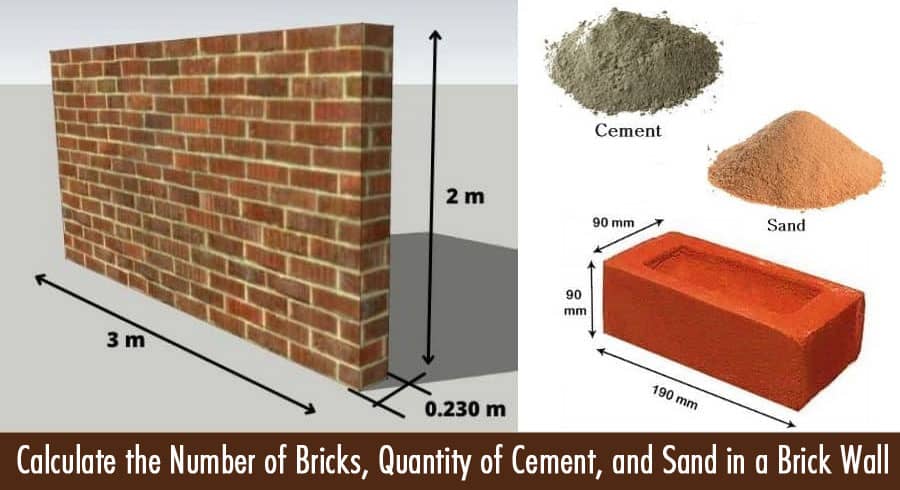Calculate the Number of Bricks, Quantity of Cement, and Sand in a Brick Wall

Building a brick wall requires precise calculations to ensure that you have the correct number of bricks and the right amount of cement and sand.
Calculate the Surface Area of the Wall
The first step is to calculate the surface area of the wall. To do this, you need to measure the length and height of the wall in meters. Multiply the length and height to get the surface area of the wall in square meters.
Calculate the Number of Bricks
The next step is to calculate the number of bricks required for the wall. You can use the following formula:
Number of bricks = (Surface area of the wall / area of one brick) x 1.1
The factor of 1.1 is added to account for wastage, breakages, and cut bricks. The standard size of a brick is 190mm x 90mm x 90mm, which has an area of 0.019m2.
For example, if the surface area of the wall is 20m2, the number of bricks required would be:
Number of bricks = (20 / 0.019) x 1.1 = 1158
So, you would need 1158 bricks for a wall with a surface area of 20m2.
Calculate the Quantity of Cement
The next step is to calculate the quantity of cement required for the wall. You can use the following formula:
Quantity of cement = (Number of bricks x cement per brick) / ratio of cement
The standard ratio of cement to sand in mortar is 1:6. This means that for every one part cement, you need six parts sand.
The amount of cement per brick depends on the thickness of the mortar joint. For a 10mm thick joint, you would need 0.0023m3 of mortar per brick.
For example, if you need 1158 bricks and you are using a 10mm thick mortar joint, the quantity of cement required would be:
Quantity of cement = (1158 x 0.0023) / 1:6 = 47 bags (assuming a standard bag of cement is 50kg)
Calculate the Quantity of Sand
The final step is to calculate the quantity of sand required for the wall. You can use the following formula:
Quantity of sand = (Number of bricks x sand per brick) / ratio of sand
The amount of sand per brick also depends on the thickness of the mortar joint. For a 10mm thick joint, you would need 0.015m3 of sand per brick.
For example, if you need 1158 bricks and you are using a 10mm thick mortar joint, the quantity of sand required would be:
Quantity of sand = (1158 x 0.015) / 1:6 = 289 cubic feet
Conclusion
Calculating the number of bricks, quantity of cement, and sand required for a brick wall is crucial to ensure that you have the right amount of materials and minimize wastage. By following the steps outlined in this article, you can accurately calculate the materials required for your brick wall project.
FAQs
What is the standard size of a brick?
The standard size of a brick is 190mm x 90mm x 90mm.
What is the standard ratio of cement to sand in mortar?
The standard ratio of cement to sand in mortar is 1:6.
